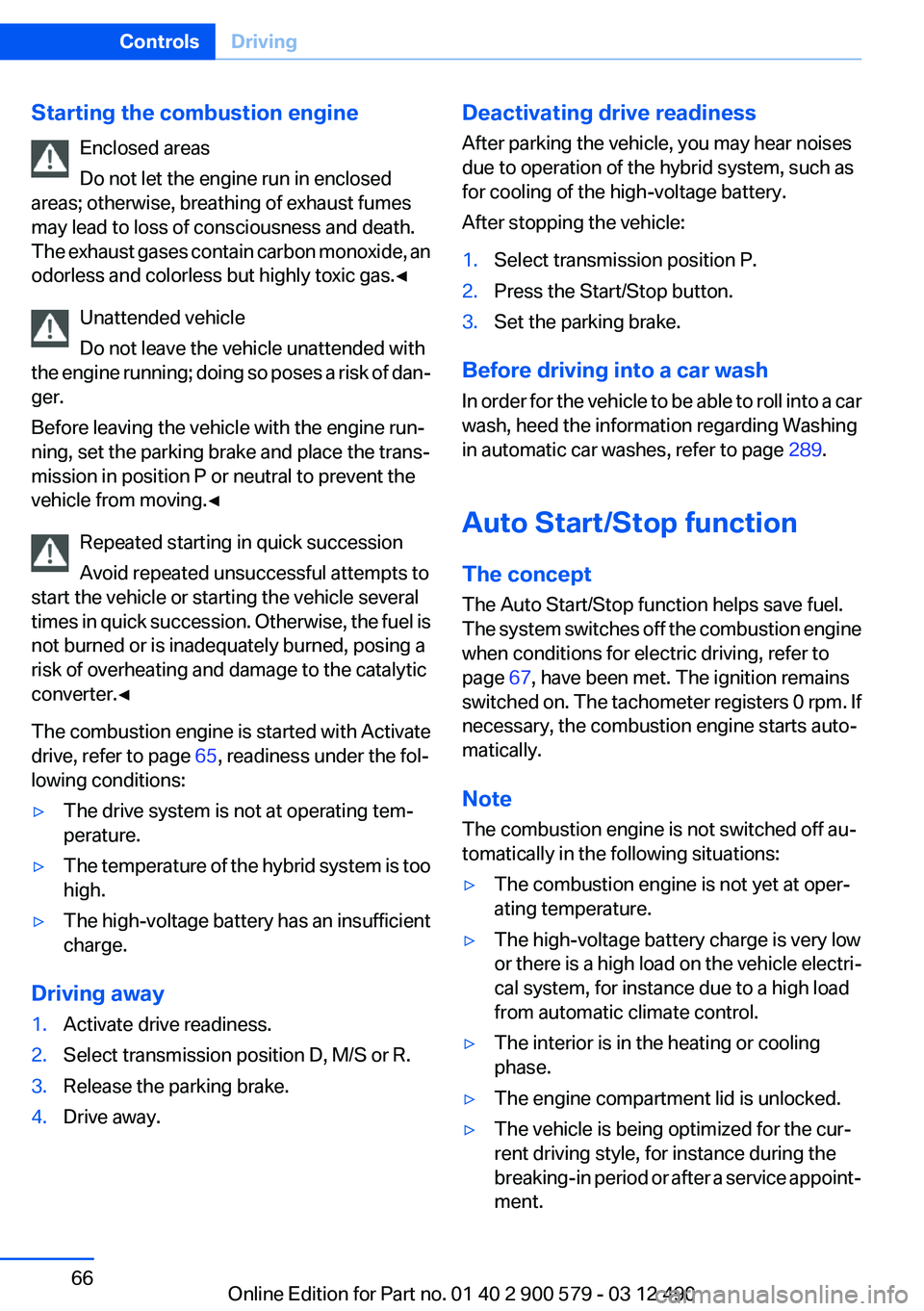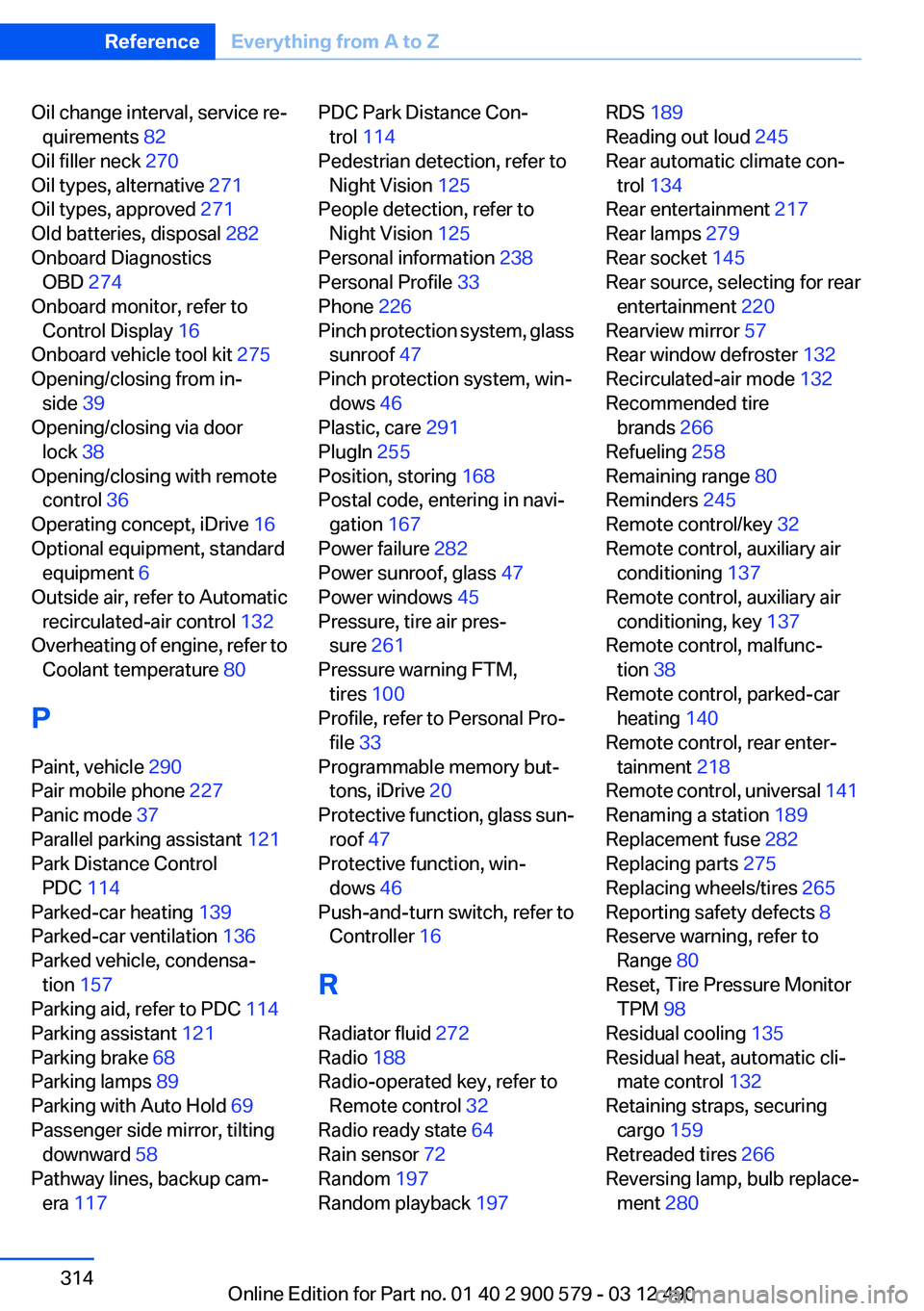engine overheat BMW ACTIVEHYBRID 5 2012 Owners Manual
[x] Cancel search | Manufacturer: BMW, Model Year: 2012, Model line: ACTIVEHYBRID 5, Model: BMW ACTIVEHYBRID 5 2012Pages: 319, PDF Size: 12.54 MB
Page 66 of 319

Starting the combustion engineEnclosed areas
Do not let the engine run in enclosed
areas; otherwise, breathing of exhaust fumes
may lead to loss of consciousness and death.
The exhaust gases contain carbon monoxide, an
odorless and colorless but highly toxic gas.◀
Unattended vehicle
Do not leave the vehicle unattended with
the engine running; doing so poses a risk of dan‐
ger.
Before leaving the vehicle with the engine run‐
ning, set the parking brake and place the trans‐
mission in position P or neutral to prevent the
vehicle from moving.◀
Repeated starting in quick succession
Avoid repeated unsuccessful attempts to
start the vehicle or starting the vehicle several
times in quick succession. Otherwise, the fuel is
not burned or is inadequately burned, posing a
risk of overheating and damage to the catalytic
converter.◀
The combustion engine is started with Activate
drive, refer to page 65, readiness under the fol‐
lowing conditions:▷The drive system is not at operating tem‐
perature.▷The temperature of the hybrid system is too
high.▷The high-voltage battery has an insufficient
charge.
Driving away
1.Activate drive readiness.2.Select transmission position D, M/S or R.3.Release the parking brake.4.Drive away.Deactivating drive readiness
After parking the vehicle, you may hear noises
due to operation of the hybrid system, such as
for cooling of the high-voltage battery.
After stopping the vehicle:1.Select transmission position P.2.Press the Start/Stop button.3.Set the parking brake.
Before driving into a car wash
In order for the vehicle to be able to roll into a car
wash, heed the information regarding Washing
in automatic car washes, refer to page 289.
Auto Start/Stop function
The concept
The Auto Start/Stop function helps save fuel.
The system switches off the combustion engine
when conditions for electric driving, refer to
page 67, have been met. The ignition remains
switched on. The tachometer registers 0 rpm. If
necessary, the combustion engine starts auto‐
matically.
Note
The combustion engine is not switched off au‐
tomatically in the following situations:
▷The combustion engine is not yet at oper‐
ating temperature.▷The high-voltage battery charge is very low
or there is a high load on the vehicle electri‐
cal system, for instance due to a high load
from automatic climate control.▷The interior is in the heating or cooling
phase.▷The engine compartment lid is unlocked.▷The vehicle is being optimized for the cur‐
rent driving style, for instance during the
breaking-in period or after a service appoint‐
ment.Seite 66ControlsDriving66
Online Edition for Part no. 01 40 2 900 579 - 03 12 490
Page 157 of 319

Braking safely
Your vehicle is equipped with ABS as a standard
feature.
Applying the brakes fully is the most effective
way of braking in situations when this is neces‐
sary.
The vehicle maintains steering responsiveness.
You can still avoid any obstacles with a minimum
of steering effort.
Pulsation of the brake pedal and sounds from
the hydraulic circuits indicate that ABS is in its
active mode.
Objects in the area around the pedals No objects in the area around the pedals
Keep floor mats, carpets, and any other
objects out of the area of motion of the pedals;
otherwise, the function of the pedals could be
impeded while driving
Do not place additional floor mats over existing
mats or other objects.
Only use floor mats that have been approved for
the vehicle and can be properly fixed in place.
Ensure that the floor mats are securely fastened
again after they were removed for cleaning, for
example.◀
Driving in wet conditions
When roads are wet or there is heavy rain, briefly
exert gentle pressure on the brake pedal every
few miles.
Ensure that this action does not endanger other
road users.
The heat generated in this process helps dry the
brake discs and pads.
In this way braking efficiency will be available
when you need it.
Hills
Drive long or steep downhill gradients in the gear
in which the least braking is required. Otherwise,the brake system may overheat, resulting in a
reduction in the brake system efficiency.
You can increase the engine's braking effect by
shifting down, going all the way to first gear, if
necessary.
Automatic transmission:
You can increase the engine's braking effect by
shifting down in the manual mode of the auto‐
matic transmission.
Avoid load on the brakes
Avoid placing excessive load on the brake
system. Light but consistent brake pressure can
lead to high temperatures, brake wear and pos‐
sibly even brake failure.◀
Do not drive in neutral
Do not drive in neutral or with the engine
stopped, as doing so disables engine braking. In
addition, steering and brake assist is unavailable
with the engine stopped.◀
Brake disc corrosion
Corrosion on the brake discs and contamination
on the brake pads are furthered by:▷Low mileage.▷Extended periods when the vehicle is not
used at all.▷Infrequent use of the brakes.
Corrosion occurs when the minimum pressure
that must be exerted by the pads during brake
applications to clean the discs is not reached.
Should corrosion form on the brake discs, the
brakes will tend to respond with a pulsating ef‐
fect that generally cannot be corrected.
Condensation under the parked vehicle
When using the automatic climate control, con‐
densation water develops that exits underneath
the vehicle.
Therefore, traces of condensed water under the
vehicle are normal.
Seite 157Things to remember when drivingDriving tips157
Online Edition for Part no. 01 40 2 900 579 - 03 12 490
Page 314 of 319

Oil change interval, service re‐quirements 82
Oil filler neck 270
Oil types, alternative 271
Oil types, approved 271
Old batteries, disposal 282
Onboard Diagnostics OBD 274
Onboard monitor, refer to Control Display 16
Onboard vehicle tool kit 275
Opening/closing from in‐ side 39
Opening/closing via door lock 38
Opening/closing with remote control 36
Operating concept, iDrive 16
Optional equipment, standard equipment 6
Outside air, refer to Automatic recirculated-air control 132
Overheating of engine, refer to Coolant temperature 80
P
Paint, vehicle 290
Pair mobile phone 227
Panic mode 37
Parallel parking assistant 121
Park Distance Control PDC 114
Parked-car heating 139
Parked-car ventilation 136
Parked vehicle, condensa‐ tion 157
Parking aid, refer to PDC 114
Parking assistant 121
Parking brake 68
Parking lamps 89
Parking with Auto Hold 69
Passenger side mirror, tilting downward 58
Pathway lines, backup cam‐ era 117 PDC Park Distance Con‐
trol 114
Pedestrian detection, refer to Night Vision 125
People detection, refer to Night Vision 125
Personal information 238
Personal Profile 33
Phone 226
Pinch protection system, glass sunroof 47
Pinch protection system, win‐ dows 46
Plastic, care 291
PlugIn 255
Position, storing 168
Postal code, entering in navi‐ gation 167
Power failure 282
Power sunroof, glass 47
Power windows 45
Pressure, tire air pres‐ sure 261
Pressure warning FTM, tires 100
Profile, refer to Personal Pro‐ file 33
Programmable memory but‐ tons, iDrive 20
Protective function, glass sun‐ roof 47
Protective function, win‐ dows 46
Push-and-turn switch, refer to Controller 16
R
Radiator fluid 272
Radio 188
Radio-operated key, refer to Remote control 32
Radio ready state 64
Rain sensor 72
Random 197
Random playback 197 RDS 189
Reading out loud 245
Rear automatic climate con‐ trol 134
Rear entertainment 217
Rear lamps 279
Rear socket 145
Rear source, selecting for rear entertainment 220
Rearview mirror 57
Rear window defroster 132
Recirculated-air mode 132
Recommended tire brands 266
Refueling 258
Remaining range 80
Reminders 245
Remote control/key 32
Remote control, auxiliary air conditioning 137
Remote control, auxiliary air conditioning, key 137
Remote control, malfunc‐ tion 38
Remote control, parked-car heating 140
Remote control, rear enter‐ tainment 218
Remote control, universal 141
Renaming a station 189
Replacement fuse 282
Replacing parts 275
Replacing wheels/tires 265
Reporting safety defects 8
Reserve warning, refer to Range 80
Reset, Tire Pressure Monitor TPM 98
Residual cooling 135
Residual heat, automatic cli‐ mate control 132
Retaining straps, securing cargo 159
Retreaded tires 266
Reversing lamp, bulb replace‐ ment 280 Seite 314ReferenceEverything from A to Z314
Online Edition for Part no. 01 40 2 900 579 - 03 12 490